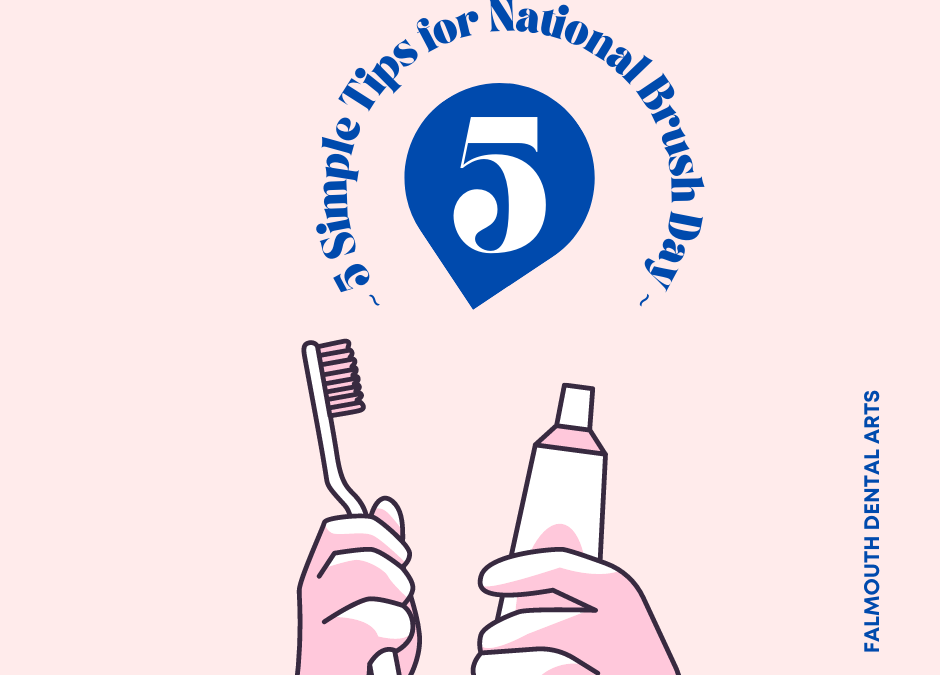
Nov 1, 2022
November 1st is National Brush Day and we’re celebrating all month by raising awareness about the importance of good tooth brushing habits. At FDA, we always love an opportunity to share our oral health care recommendations and have 5 tooth brushing tips to share with you!
1) Look for the American Dental Association’s Seal of Approval
Choose a toothbrush (and toothpaste!) that displays the American Dental Association’s (ADA) Seal of Acceptance. Both manual and electric toothbrushes can thoroughly clean your teeth and gums when done correctly; we prefer electric toothbrushes for their superior plaque-fighting powers. Make sure you select a toothbrush with extra-soft or soft bristles. For help choosing a toothbrush, ask the FDA team for a recommendation!
2) Brush Twice a Day to Keep Cavities at Bay
We recommend brushing a minimum of two times per day for at least two minutes each time. The ADA has updated its list of proper tooth brushing techniques to include the following:
- Place your toothbrush at a 45-degree angle to the gums.
- Gently move your toothbrush in a circular motion (tooth-wide) to mimic the motion of an electric toothbrush.
- Brush all outer surfaces and inner surfaces as well as the chewing surfaces of your teeth.
- To clean the inside surfaces of the front teeth, tilt the brush vertically and make several up-and-down strokes.
Feel free to ask your hygienist for a demonstration of proper brushing techniques at your next appointment. Our team of compassionate dental professionals really love educating patients!
3) Wait 30 Minutes After Acidic Food & Drinks
Brushing right after eating or drinking acidic food and drinks can damage your tooth enamel. This includes citrus foods or juices, carbonated beverages, and wine. Drink some water to rinse your mouth instead, or simply wait 30 minutes until you brush.
4) Out with the Old, In with the New
Replace your toothbrushes every three to four months, or more often if the bristles are starting to show signs of wear, such as crooked or frayed bristles. We are always happy to give you a new toothbrush at your next appointment…just ask!
5) Show Your Toothbrushes Some TLC
Rinse your toothbrush thoroughly after you use it and store it in an upright position, allowing it to air dry each time. This will reduce the growth of bacteria in between brushing sessions.
Dec 19, 2013
It’s that time of year again… along with the cold weather comes, well…colds. Stuffy noses, sore throats, headaches, coughing – you know the drill. ‘Tis the season.
But did you know that an infection or abscess in your back teeth can spread into your maxillary sinus and cause an infection there as well?
As you might know, you have several sinuses, but only one of those sets can be affected by tooth-related issues. The maxillary sinuses are on either side of your nose and come in close contact with the roots of your upper teeth. Because the two are so close, abscesses from the upper back teeth can make their way into your maxillary sinus and cause an infection.
Most cases are due to a viral infection and resolve over the course of 10 days. However, if your sinus infection or toothache has been nagging for weeks, you may have a maxillary sinus infection that relates to an unknown infection in your teeth! So if you are prone to sinus infections, you may not think to visit with us, but perhaps you should!
Here are some common signs and symptoms of sinus infections:
- Headache, localized facial pain/pressure, or toothache – a dull, constant, or aching sort over the affected sinuses is common with both acute and chronic stages of sinusitis. This pain is typically localized to the involved sinus and may worsen when the affected person bends over or when lying down. Pain often starts on one side of the head and progresses to both sides.
- Acute and chronic sinusitis may be accompanied by thick nasal discharge that is usually green in color and may contain pus (purulent) and/or blood.
- Infection of the eye socket is possible, which may result in the loss of sight and is accompanied by fever and severe illness. Another possible complication is the infection of the bones of the forehead and other facial bones.
- Sinus infections can also cause middle ear problems due to the congestion of the nasal passages. This can be demonstrated by dizziness, “a pressurized or heavy head”, or vibrating sensations in the head.
- Other symptoms of sinusitis include bad breath and Post-nasal drip.
Generally, tooth abscesses are painful. However, once in a while there’s no discomfort at all—it depends on the location of the infection. If you’re experiencing pain (even if the pain goes away), or any of the other symptoms listed above, let us know. We can help catch problems—and infections—before they spread.
Source: http://dentaltipz.blogspot.com/2013/12/sinusitis-and-dental-office.html

